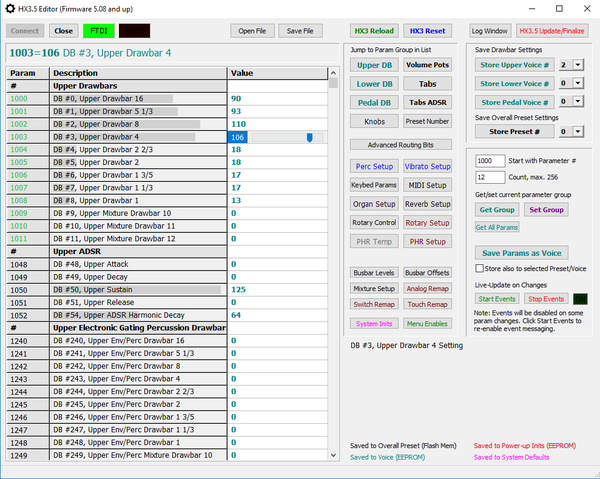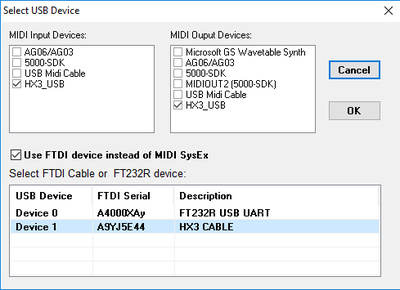HX3.5 Editor User Manual
Preface
HX3.5 Editor is a tool for adjusting HX3.5 parameters and setups. Compared to HX3.4 Remote, number of tweakable parameters have been vastly increased (more than 800), so a new design was necessary. HX3.5 Editor connects to HX3.5 mainboard by a USB-to-serial adaptor cable FT232R-5V (available in our shop) or a USB-to-serial adaptor circuit with FTDI interface chip.
Sorry, only Windows version available (Windows XP and up). A version to connect also by MIDI over USB is online on August 1st, 2018.
Installation
No installation is necessary. Just make sure all files contained in HX3.5 Editor ZIP file are copied to a folder on your local harddisk. Main parameter table and dropdown lists are defined in .INI text files which must be present in same folder as HX3.5 application.
Connection
HX3,5 Editor connects to HX3.5 mainboard either through bi-directional MIDI connection (IN/OUT) using a third-party MIDI cable, by MIDI over USB using a USB connection or by our FTDI serial adaptor cable. Also, any FTDI device with FT232 chip as our FTDI serial adaptor board may be used. Note: FTDI connection is somewhat faster than MIDI.
MIDI connection
When HX3.5 is connected to your PC's USB port, it will appear as "HX3_USB" in list of input/output devices. Per default, these items are checked in HX3.5 Editor's Connect window, so connection will use the MIDI over USB. Protocol is proprietary SysEx, so other devices will not respond to HX3.5 Editor commands. Note: On some PCs, intermediate USB hubs will not work -- use a direct USB connection instead.
FTDI cable connection
Attach USB-to-serial adaptor cable FT232R-5V to any PC USB port and HX3.5 6-pin header PL19, black wire (BK) facing to black header PL17. On first install, Windows will install FTDI drivers automatically (Win XP needs manual FTDI driver installation). Power up HX3.5, Open HX3.5 Editor application and click on Connect. A dialog window will appear which asks for the FTDI device to use. Check Use FTDIdevive instead of MIDI" box. Select FT232R entry and click OK. HX3.5 Editor will wait for communication established and reads all parameters from HX3.5 mainboard. Log window will show all activities as well as (plain text) answers from HX3.5 mainboard.
Basic Settings
Start HX3.5 Editor, connect to HX3.5 and open HX3.5 Update/Finalize window. Complete or partly updates may be triggered by pull-down menus here. "Get Board Info" should show current configuration. Checklist:
- Is appropiate Scan Driver installed? Should be either MIDI Input (Plexi Expander or Drawbar Expander FW) or FatarScan driver (other firmwares). You may replace the Scan Driver with help of HX3.5 Editor. Use pull-down menus and select "Scan Driver file". HX3.5 Editor will prompt for a DAT file, open either scanmidi.dat or scanfatr.dat from SDCARD folder, depending on your needs.
- Are HX3.5 System Inits correct? HX3.5 will not scan buttons or analog inputs if not set correctly. Go to HX3.5 main window and click on pink System Inits button. See Editing Parameters section below how to do this.
Editing Parameters
The main table lists all 800+ editable HX3.5 parameters. An active "range" is marked by green parameters. To find a particular parameter range, click on corresponding button in "Jump to Param Group in List" bevel. These buttons just search for the respective item line, nothing else. Click on parameter line you want to edit.
A help text for selected parameter appears on right bottom of main window. Depending on type of parameter, either an editable scroll bar, an ON/OFF button or a dropdown list appears on parameter line. Some parameters do not have a special visual control, just the number itself.
Click on teal colored Get Range button to refresh values from HX3.5 board (e.g. to display current drawbar setting). Set Range will send whole range to HX3.5 (usually not necessary since parameter uplink is always "live").
Saving Parameters
Changes to parameters are executed instantly, but they are temporary until you save their parameter range. Save destination is dependant on type of parameter (see color coding at right bottom of main window).
To save teal colored Voice settings (drawbar positions) to a particular Voice Preset, select Voice number (dropdown list) for that manual and click one of Store Upper/Lower/Pedal Voice # buttons according to parameter group (upper/lower/pedal).
Black coloured parameter values are saved to overall (common) presets by selecting desired preset number first and than clicking "Store Preset #".
Red coloured parameter values are saved to a Common Preset; click Store Preset # to save. Additionally, they are saved as a startup default for all voices and presets in common. Click large red Set Params as Default button to save as initialisation value.
Pink coloured parameter values (System Inits) are saved as a startup default for all voices and presets in common. Click large red Set Params as Default button to save as initialisation value. These parameters are persistent even with a major firmware update. Check thoroughly if your hardware configuration changed. Always check on first-time use of brand new mainboard which is configured as MIDI expander from factory.
Note: Parameters can also be saved as an initialisation default ("empty" voice preset content when finalizing a board). Click Save as Init Default to do so. Grayed-out parameters should not be changed.
Testing Controls
Manual Table Refresh
Parameter display will not update until you click Get Range or Get all Params. With all analog inputs enabled (parameter 1503=2), check if changes on drawbars are to be seen on Upper DB resp. all other analog input groups when clicking Get Group button. Non-working analog inputs may have been remapped to "not assigned". See Analog Remap group.
Live Events
Note: Following description applies to FTDI cable connection only!
Click green Start Events button to enable live update of displayed parameters (when it's range is visible in main table, data will change instantly). HX3.5 mainboard sends an "event" to the editor when it detects a change of any analog or digital control. The Log Window will show each event. If an analog input is floating (not connected), it is likely you will get random data on a particular parameter number. Click Stop Events to cancel live parameter updates. Note: Some functions (saving value ranges, presets, finalizing) also stop event messaging; re-enable with Start Events if needed.
Example: To check operating range and mapping order of volume potentiometers, click "Volume Pots" button to display corresponding parameter range. Click "Start Events" and work the potentiometer knobs; values received should range from 0 to 127. If a pot refuses to work, it is likely that it's analog input has not mapped or re-mapped to the desired analog function (see Analog Remap section).
Updates and Scan Drivers
For updates, entering extended licences or changing Scan Driver from MIDI to FatarScan2 or Scan16/61, click on HX3.5 Update/Finalize. A window will open showing active board licences and serial number. Make sure at least Organ Licence "LED" is lit.
Scan Driver Change via SD Card
Attach SD card adaptor to PL17 and insert SD card containing all update files (ZIPs available in our Github Repo). Select "INI=scanXXX.ini" entry in dropdown box under Commands & INI Scripts. XXX stands for desired scan driver (midi, fatr, 61). Click Send Cmd. SD card adaptor should show some activity. When red LED is off, Get Board Info will show if new scan driver (with version number) has beed installed.
Scan Driver Change via Upload
Select "Scan Driver file" from drop-down menu (either via MIDI or via FTDI device). HX3.5 Editor will prompt for a Scan Driver .DAT file (either scanmidi.DAT or scanfatr.DAT at this time). Scan Drivers can be found in SDCARD directories resp. ZIP files.
FPGA and Firmware Updates via SD Card
To install a new firmware or FPGA image (sound engine), attach SD card adaptor to PL17 and insert SD card containing all update files (ZIPs available in our Github Repo). Click Update All, Update FW only (controller firmware) resp. Update FPGA only (sound engine). Note: Update FPGA only will also install new generator waveforms, tapering files and scan driver from card if they are present.
Please also see HX3.5 Firmware Updates page for details of SD card content as well as automated updates.
FPGA and Firmware Updates via Upload
Analog to Scan Driver updates, individual parts may be updated by file upload also, using a MIDI USB or FTDI cable serial connection. Please note: File transfer of FPGA (sound engine) configuration may take up to 10 minutes using a MIDI connection or up to 4 minutes using the FTDI serial cable. For a complete update, each file must be uploaded individually! For experienced users: You may skip some files if their creation date is not different from those already installed.
Extended Licences
Make sure that green Organ Licence "LED" is already lit. To install an Extended Licence, enter number in Extended Licence text field and click Send Licences/Name.
User Name
Make sure that at least green Organ Licence "LED" is already lit. To change the user name, enter name in New User Name text field and click Send Licences/Name.

